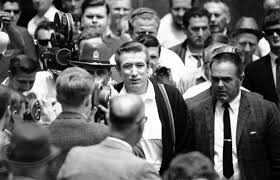Richard Speck remains one of the most notorious figures in American true crime history, infamous for the brutal 1966 murders of eight student nurses in Chicago. His name evokes images of senseless violence that shocked the nation and redefined perceptions of mass murder. If you’re searching for “Richard Speck” to learn about his troubled life, the horrific crime, trial, imprisonment, and enduring legacy, this comprehensive, easy-to-read guide breaks it all down. From his abusive childhood to his unrepentant end, we’ll explore the facts with sensitivity to the victims and their families.

Early Life: A Childhood Marked by Loss and Abuse
Born Richard Benjamin Speck on December 6, 1941, in rural Kirkwood, Illinois, Speck was the seventh of eight children in a devout Baptist family. His father, Benjamin Franklin Speck, a factory worker and former farmer, died of a heart attack in 1947 when Richard was just six—devastating the boy who was especially close to him. His mother, Mary Margaret Carbaugh, remarried in 1950 to Carl August Rudolph Lindberg, a hard-drinking, abusive traveling salesman with a lengthy criminal record.
The family relocated to Dallas, Texas, where Speck endured frequent moves across 10 rundown neighborhoods, constant belittling from his stepfather, and a strict religious household that clashed with his growing rebellion. He struggled academically—refusing glasses, repeating grades, and dropping out of high school in 1958 after failing ninth grade. By age 12, Speck was drinking heavily, leading to his first arrest at 13 for trespassing. Over the next decade, he racked up over 40 arrests for petty crimes like burglary, forgery, and disorderly conduct.
In 1961, at 19, Speck married 15-year-old Shirley Annette Malone after getting her pregnant; their daughter, Robbie Lynn, was born in 1962. But his volatility ended the marriage quickly. By 1963, he was imprisoned for forgery and burglary, serving 16 months before parole in 1965. A brief release led to another assault conviction, and by early 1966, divorced and jobless, Speck fled to Chicago to evade warrants.
Criminal History: Escalation from Petty Crime to Violence
Speck’s pre-murder record was a spiral of escalating aggression. In Texas, he worked odd jobs like laborer at a 7-Up bottling plant but was fired for absenteeism and accidents. He fathered a child out of wedlock and stabbed a man in a bar fight in January 1966, pleading down to a minor charge.
In Illinois (March–April 1966), staying with relatives in Monmouth, Speck burglarized homes and raped a 65-year-old woman at knifepoint. On April 9, he murdered 32-year-old barmaid Mary Kathryn Pierce in a hog house behind a tavern he frequented—bludgeoning her to death after she rejected his advances. Police suspected him but lacked evidence.
In Chicago from April to July 1966, Speck briefly joined the Merchant Marine, getting discharged for drunkenness. He lived with his sister, committed burglaries, and on July 12, raped 53-year-old Ella Mae Hooper at knifepoint, stealing her .22 pistol. Broke and desperate, he spent July 13 drinking heavily, setting the stage for his deadliest act.
| Key Pre-Murder Crimes | Date | Details |
|---|---|---|
| Forgery & Burglary | 1963 | Sentenced to 3 years; served 16 months in Texas prison. |
| Aggravated Assault | Jan 1965 | Knife attack on a woman; served 6 months. |
| Rape & Burglary | Apr 1966 | Attacked 65-year-old Virgil Harris in Monmouth, IL. |
| Murder of Mary Kathryn Pierce | Apr 9, 1966 | Bludgeoned barmaid; unsolved at the time. |
| Rape of Ella Mae Hooper | Jul 12, 1966 | Knifepoint assault; stole her gun. |
The 1966 Chicago Nurse Murders: A Night of Unspeakable Horror
On July 13, 1966, around 11 p.m., a drunken Speck broke into a townhouse dormitory at 2319 E. 100th St. in Chicago’s Jeffery Manor neighborhood. Home to nine student nurses from South Chicago Community Hospital, the women—mostly in their early 20s—were unwinding after shifts.
Using a knife and stolen pistol, Speck bound and terrorized them, methodically leading victims one by one into other rooms for 20–30 minutes each. He raped one, strangled, stabbed, or slashed throats of eight over four hours:
- Gloria Jean Davy, 22 (raped and strangled)
- Suzanne Bridgit Farris, 21 (stabbed)
- Merlita Ornado Gargullo, 23 (strangled)
- Mary Ann Jordan, 20 (stabbed)
- Patricia Ann Matusek, 20 (strangled)
- Valentina P. Pasion, 24 (throat slashed)
- Nina Jo Schmale, 24 (stabbed)
- Pamela Lee Wilkening, 20 (stabbed)
Ninth resident Corazon “Cora” Amurao, 23, survived by clinging to a bedspring under a bed until dawn, whispering “breathe” to stay silent. Speck, possibly intoxicated and erratic, may have lost count or forgotten her. He fled around 3:30 a.m., leaving a blood-soaked scene discovered at 6 a.m. The murders—dubbed the “crime of the century”—stunned Chicago and the nation, with media frenzy amplifying the horror.
Arrest and Trial: Swift Justice in the Spotlight
A massive manhunt ensued, fueled by Amurao’s description of Speck’s “Born to Raise Hell” arm tattoo. On July 17, after a failed suicide attempt (slashing his wrists and overdosing at a flophouse), Speck was rushed to Cook County Hospital. Dr. LeRoy Smith recognized the tattoo from news reports and alerted police, leading to his arrest.
Held without questioning due to the recent Miranda ruling, Speck underwent psychiatric evaluations deeming him sane and competent. His high-profile trial began April 3, 1967, in Peoria to avoid bias. Amurao dramatically identified him in court: “This is the man.” Fingerprints and her testimony sealed the case. After 49 minutes of deliberation, the jury convicted him on all eight counts on April 15, recommending death by electrocution. Sentenced June 5, 1967, appeals failed until the U.S. Supreme Court intervened.
Imprisonment and Controversies: Life Behind Bars
Speck’s death sentence was vacated in 1971 (Witherspoon v. Illinois) and commuted to 400–1,200 years (eight consecutive 50–150 year terms) in 1972 after Furman v. Georgia struck down capital punishment nationwide. Later reduced to 100–300 years, he spent his days at Stateville Correctional Center, earning the nickname “Birdman” for nurturing pet sparrows (one of which he later killed).
Parole denials were routine. In a 1978 interview, Speck confessed publicly but showed no remorse, saying he’d redo it as a “simple burglary.” A 1988 inmate video, smuggled out and aired in 1996, shocked viewers: Speck, with hormone-induced breasts, silk panties, cocaine, and casual boasts about the murders (“It just wasn’t their night”), performing acts with inmates. It sparked outrage over prison conditions and his lack of rehabilitation.
A debunked controversy: His defense floated the “XYY syndrome” (extra Y chromosome causing aggression), but tests confirmed normal XY chromosomes; media hype stigmatized it anyway.
Death: A Quiet End to a Monstrous Life
On December 5, 1991—one day before his 50th birthday—Speck died of a heart attack at Silver Cross Hospital in Joliet, Illinois, after chest pains. Contributing factors included an enlarged heart, emphysema, and clogged arteries from years of smoking and drug use. Cremated at his sister’s request to prevent grave vandalism, his ashes were scattered secretly near Joliet. He left behind a daughter and siblings, but no legacy of redemption.
Media Depictions and Legacy: From Courtroom Drama to Modern True Crime
Speck’s story inspired books like Born to Raise Hell (1967) by his psychiatrist Marvin Ziporyn and The Crime of the Century (1993) by prosecutor William J. Martin. Films include Chicago Massacre: Richard Speck (2007). Recent buzz surrounds Netflix’s Monster: The Ed Gein Story (2025), where actor Tobias Jelenik portrays Speck as a fictional “pen pal” to Ed Gein, crediting him as inspiration—though no real connection existed. The series has spiked Wikipedia views and X discussions, with users calling it “hot trash” for exploiting killers like Speck.
His crimes marked America’s “first mass motiveless murder,” fueling debates on the death penalty, mental health, and prison reform. The murders led to stricter maritime hiring and heightened awareness of violence against women.
Expert Opinion: Why Richard Speck’s Case Still Haunts Criminology
True crime author and FBI profiler John E. Douglas (Mindhunter) described Speck as a “classic sexual sadist” whose motiveless rage exemplified the shift to random mass killings in the 1960s. Prosecutor William J. Martin, in The Crime of the Century, noted: “Speck wasn’t insane—he was evil, plain and simple. His trial exposed how a broken system let a monster slip through.” In 2025, amid Monster backlash, cultural critic Sarah Weinman told People: “Depictions like this glamorize unchecked depravity, but Speck’s real legacy is a call for better victim support and early intervention in abuse cycles.” His story underscores criminology’s focus on environmental factors over debunked genetics like XYY.
Frequently Asked Questions About Richard Speck
What was Richard Speck’s most infamous crime?
The July 13–14, 1966, murders of eight student nurses in Chicago, where he bound, raped, and killed them over four hours; one survivor hid under a bed.
How was Richard Speck caught?
After a suicide attempt on July 17, 1966, he was treated at Cook County Hospital, where a doctor recognized his “Born to Raise Hell” tattoo from news sketches.
Why was Speck’s death sentence commuted?
The U.S. Supreme Court ruled the death penalty unconstitutional in 1972 (Furman v. Georgia), resentencing him to 400–1,200 years in prison.
What was the 1988 prison video about?
A leaked tape showed Speck unrepentant, using drugs, boasting about the murders, and engaging in explicit acts—aired in 1996, it fueled prison reform calls.
Did Richard Speck show remorse?
No— in interviews and the video, he shrugged off the killings (“It just wasn’t their night”) and expressed none.
Is Richard Speck connected to Ed Gein?
Fictionalized in Netflix’s 2025 Monster: The Ed Gein Story as a “pen pal,” but no real evidence links them; it’s creative liberty.
Summary: Richard Speck’s Dark Shadow on History
Richard Speck’s life—from an abusive childhood to the 1966 slaughter of eight innocent nurses—epitomizes unchecked violence that scarred Chicago and America. Convicted swiftly, his sentence commuted amid legal shifts, he died unrepentant in 1991, leaving a trail of trauma. Today, amid true crime revivals like Monster, his story warns of systemic failures in addressing early abuse and crime. Honor the victims—Gloria, Suzanne, Merlita, Mary Ann, Patricia, Valentina, Nina, and Pamela—by advocating for prevention and justice. For deeper dives, explore survivor Corazon Amurao’s resilience or the trial’s archival footage.
https://www.ebsco.com/research-starters/history/richard-speck

